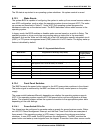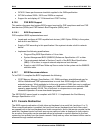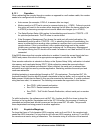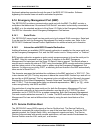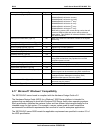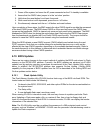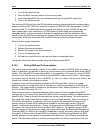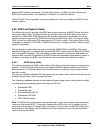
BIOS Intel® Server Board SE7501WV2 TPS
Revision 1.0
Intel reference number C25653-001
88
The BIOS provides setup options to configure the Service Partition type (the default is 98h), and
the option for enabling and disabling the Service Partition boot. A remote agent can direct the
BMC firmware to set the Service Partition boot request and reboot the system.
Upon rebooting, the system BIOS checks for a service partition boot request. On finding a boot
request, the system searches for the service partition type starting from the highest disk number
in the scan order. If a service partition is found, the system boots from it. The drive containing
the service partition becomes the C: drive.
The drive numbers of all other drives are incremented by one, except for the drive that has a
scan order that is higher than the Service partition drive. The BIOS can be directed by the user
to perform a one-time boot from the service partition. The service partition is serviced once per
request. The service partition boot option is disabled upon each boot attempt.
The BIOS considers a Service Partition boot as a continuation of the BIOS POST. The BIOS
does not hide the serial port that is used by console redirection or the Emergency Management
Port if it is booting to the Service Partition. The state of all Emergency Management Port
functionality remains in the same state as in POST. The state of Pre-Boot and Always-Active
EMP mode also do not change. The Service Partition is always scanned for presence, even if
Service Partition booting is inactive.
The BIOS sets the watchdog timer inside BMC while it is attempting to boot from a Service
Partition. This timer is reset upon booting of the Service Partition by an application. If the system
hangs on booting, a reset brings the system out of the Service Partition boot and an error is
logged.
The BIOS starts serial console redirection on a service partition boot. Console redirection is
controlled by IPMI commands and synched to BMC serial port parameters. Any reboot after a
service partition boot reverts to the previous settings of Serial Console Redirection. For
example, if console redirection was turned off before the service boot, it reverts to disabled.
6.16 System Management BIOS (SMBIOS)
This section references the System Management BIOS Reference Specification, Version 2.3.
The Desktop Management Interface Specification and its companion, the DMTF Systems
Standard Groups Definition, define “…manageable attributes that are expected to be supported
by DMI-enabled computer systems.” Many of these attributes do not have a standard interface to
the management software, but are known by the system BIOS. The system BIOS provides this
interface via data structures through which system attributes are reported.
The system administrator can use SMBIOS to obtain the types, capabilities, operational status,
installation date, and other information about the system components. The SE7501WV2 BIOS
provides the SMBIOS structures via a table-based method. The table convention, provided as
an alternative to the calling interface, allows the SMBIOS structures to be accessed under 32-bit
protected-mode operating systems such as Windows NT*. This convention provides a
searchable entry-point structure that contains a pointer to the packed SMBIOS structures
residing somewhere in 32-bit physical address space.
The SMBIOS entry-point structure described below can be located by application software by
searching for the anchor-string on paragraph (16-byte) boundaries within the physical memory



